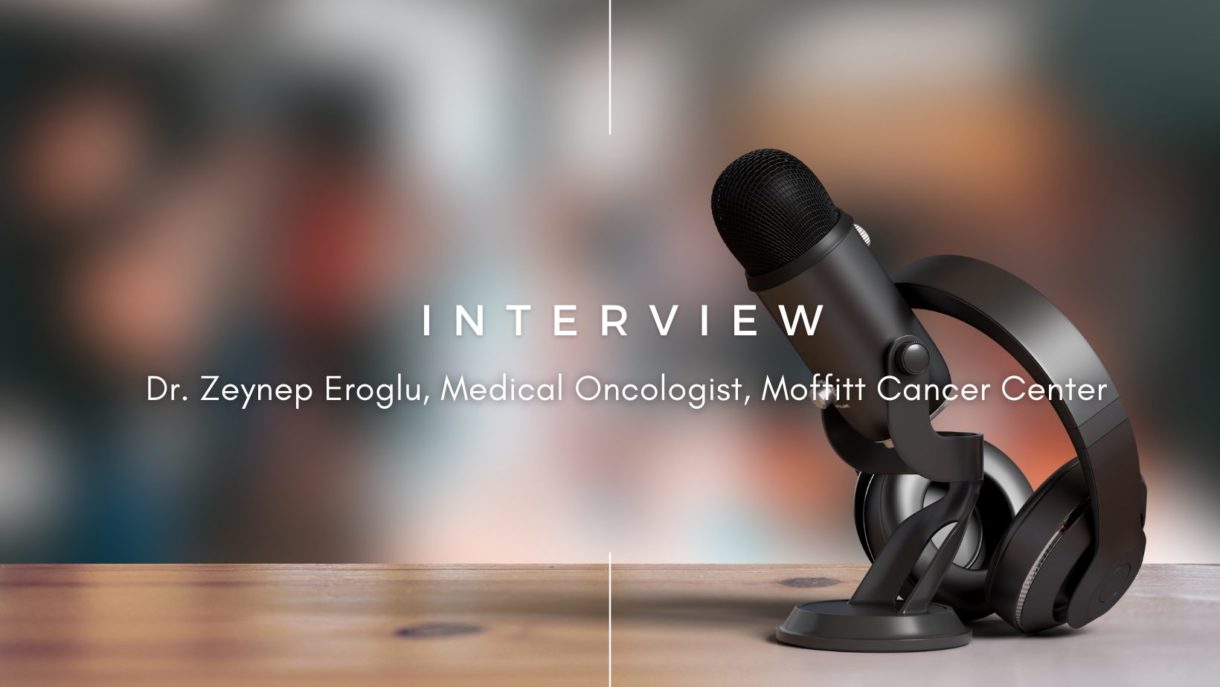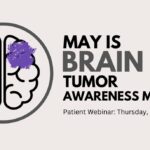
 Dr. Zeynep Eroglu is a medical oncologist at Moffitt Cáncer Center in Florida. Dr. Eroglu’s research interests are translational and clinical research in targeted therapies and combination immunotherapeutics for melanoma and other piel cancers, along with development of personalized treatment strategies and biomarkers for patients with melanoma. Dr. Eroglu is also a member of Las mujeres en el melanoma, a group that the late Valerie Guild, founder of AIM at Melanoma, established in 2017.
Dr. Zeynep Eroglu is a medical oncologist at Moffitt Cáncer Center in Florida. Dr. Eroglu’s research interests are translational and clinical research in targeted therapies and combination immunotherapeutics for melanoma and other piel cancers, along with development of personalized treatment strategies and biomarkers for patients with melanoma. Dr. Eroglu is also a member of Las mujeres en el melanoma, a group that the late Valerie Guild, founder of AIM at Melanoma, established in 2017.
AIM interviewed Dr. Eroglu about her research and asked her to describe what feels particularly promising in her work.
What kind of research do you generally do?
My background has been in translational and clinical research—that means working with laboratory-based scientists to try to bring some of the lab findings into the clinic, especially with the design and writing of clinical trial protocols and carrying out those trials. In terms of clinical research, my work is in overseeing the conduct of clinical trials and analyzing their data, and trying to find better treatment options. I also focus on blood-based biomarkers to see if we can find better ways of surveillance for patients with melanoma.
You specialize in melanoma brain metastasis. Where does that interest come from?
Medical oncologists who specialize in the treatment of advanced skin cancers tend to see patients with late-stage melanoma, and that, unfortunately, includes a lot of patients who present with brain metastases (also referred to as brain mets) or who develop brain mets in the course of treatment. It’s a group that’s been particularly challenging in terms of treatment options, so that’s one reason for my interest. These patients have been excluded in the past from clinical trials of targeted therapies and immunotherapies, so we haven’t seen as much research on their response to therapies. But in the last five years, that’s been changing—patients with brain mets are now being allowed on some trials—so we’re starting to see results from research that does include patients with brain mets.
Why were patients with brain mets excluded from earlier clinical trials?
When immunotherapies and targeted therapies were first being tested for efficacy, the concern was that including patients with brain metastases might skew the results. Patients with brain mets in general have a worse prognosis, so if there were a lot of these patients on the trial, the trial results may not accurately reflect how Stage IV patients without brain mets fare on the treatments. Additionally, patients with symptomatic brain mets need corticosteroids. So if the patient is not responding to immunotherapy, it could be related to those high-dose steroids, but that would be hard to decipher in a clinical trial setting.
What draws you to the difficult challenge of brain mets?
I’ve seen too many patients in our clinics who have not done well on the current available treatments. Because they were excluded from so many previous clinical trials, it seemed important to focus on patients with brain mets to see if we could come up with better options for them. It is also a more complicated field, as the treatment of brain mets involves other disciplines such as radiation oncologists, neurosurgeons, and others. You truly need a multi-disciplinary approach.
Tell us about some of your ongoing research in brain mets.
At Moffitt, we’ve been involved in a prior study looking at the use of immunotherapy drugs such as ipilumamab/nivolumab (“ipi/nivo”) in patients with melanoma brain mets. The intracranial tumor response rates—how likely the brain mets are to respond—has been high, around 55% with ipi/nivo in patients with melanoma brain mets. However, this does significantly drop to only about 20% intracranial response rates for patients with symptomatic brain mets including those who are requiring corticosteroids. The challenge with BRAF/MEK inhibitor targeted therapy—an option for patients with BRAF mutant melanoma with brain mets—has been that while the intracranial response rates are high, around 58%; unfortunately, the duration of response in the brain is not very long—less than six months progression-free survival. This calls into question whether these drugs are effective on their own reaching the central nervous system.
What excites you about this research?
A large ongoing clinical trial (SWOG S2000) that I’m excited about is looking at a triplet combination of BRAF/MEK inhibitor with immunotherapy, specifically encorafenib + binimetinib + nivolumab vs ipi/nivo in patients with BRAF-mutant melanoma with brain mets. This is a large cooperative group trial run through the National Cancer Institute. It’s open at several hundred clinics and cancer centers across the country, including Moffitt. It allows patients with symptomatic brain mets to enroll—including those who are requiring corticosteroids. Basically, our hypothesis is that with the triplet approach combining BRAF/MEK inhibitor and immunotherapy together, we hope to see improved response within the brain and duration of response in the brain compared to ipi/nivo immunotherapy alone, especially in patients who have symptomatic brain mets, as those are the patients who do poorly with immunotherapy. This trial permits patients who have had prior radiation and surgery as well. I’m hoping it will enable us to identify a more effective treatment option for patients with melanoma brain mets.
When will you see results for this study?
The study began end of 2020 and it takes months for sites to activate. Because this is a relatively rare patient population—metastatic melanoma patients with brain metastasis with a BRAF mutation—we estimate that it will take at least three years or longer to complete accrual. So it will be at least two to three years before we are able to see some initial results. Clinical research is not fast!
Why the optimism?
There’s been a lot of work testing triplet regimens therapies in melanoma—anti-PD-1 with BRAF-targeted therapy. While their use in metastatic melanoma overall is not yet clearly defined, there may be a synergistic benefit with the two modalities in combination for brain mets. You may be able to get a high tumor response rate in the brain (as you see with targeted therapies) plus a durable response (what we tend to see with immunotherapies). So we think this combo may be especially superior for patients with symptomatic brain metastases.
Any other research that is exciting?
Yes: blood based biomarkers such as circulating tumor (ct) DNA assays. With the approval of anti PD-1 therapy in Stage IIB/C and Stage III post-surgical resection, we often use immunotherapy drugs in this adjuvant (post-surgical setting). And post-surgery we use imaging (CT or PET-CT scans) to monitor for any evidence of disease recurrence. But there’s not a great blood-based biomarker for melanoma the way there is, for example, PSA in prostate cancer. The only way we are able to follow for recurrence is physical exams and imaging. So there’s been a lot of work trying to find blood-based biomarkers in melanoma for disease monitoring, including in earlier stage melanoma, as it can be a minimally invasive way to monitor disease and you can obtain it much more frequently than a scan.
Circulating tumor DNA measures the DNA that’s shed from tumor cells into blood. There have been various assays to measure ctDNA in the blood and a lot of research in this area including at Moffitt. We’ve found that in patients who have a relapse of their melanoma have an increase in ctDNA levels on average about three months prior to clinical or radiographic relapse. Those who have the increase in ctDNA have much worse relapse-free survival than those whose values become or remain negative.
We’ve also looked at the use of these assays in the metastatic setting in patients who are undergoing immunotherapy. Similarly, we are seeing that the dynamics in ctDNA do seem to correspond to eventual response to the treatment. For example, if within six weeks of starting immunotherapy we’re seeing a decrease in ctDNA, most of these patients go on to have a response on their imaging to immunotherapy and have much better progression-free survival than those who have increasing ctDNA levels. Unfortunately, those patients all go on to have disease progression on their imaging and much lower survival.
What will it take to get this research turned into an actual test, like the PSA for prostate cancer?
Some of the challenges are that there are different types of ctDNA assays and different methodologies—not all of the research is necessarily using the same type of tests. And there’s also a question of the cost of these assays—they can be expensive, especially if you do sequencing of tumor tissue to design a personalized assay to follow ctDNA in a patient’s blood over time. Ultimately, what we really need is to validate these assays in clinical trials, in order to demonstrate the clinical utility of ctDNA as a biomarker, whether that’s in an adjuvant setting or a metastatic setting. At Moffitt we have a small clinical trial in melanoma where we are actually using the serial ctDNA values to make decisions on starting or withdrawing treatment. But it’s going to be important to have clinical trials with decision making based on those assays in order to determine whether ctDNA should be incorporated into the NCCN guidelines, for example, and used in routine clinical practice. For example, serial ctDNA assays could be helpful to decide more quickly whether to start or switch a treatment earlier than waiting for CT scans, because you can obtain these assays every few weeks.
Is there anything you want to add?
I would encourage patients to consider clinical trial enrollment and for their physicians to recommend them. The only way we are going to get answers to some of these questions—better treatment options, use of biomarkers, etc.—is to have patients continue to enroll in these studies.
Entradas recientes

Navigating the Journey Together – Conversations with Melanoma Caregivers

May is Brain Tumor Awareness Month

President’s Letter | April 2024

Celebrating a Milestone: 20 Years of the Dallas Steps Against Melanoma Walk

